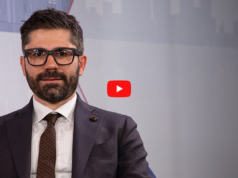 “You have to have a balanced approach.” This was the core message from Vincent Rowe (University of California Los Angeles Health, Los Angeles, USA) during his presentation on paediatric haemodialysis access at the most recent VEITHsymposium (14–18 November, New York, USA). “There is still a lot of catheter use” in paediatric patients receiving dialysis care, Rowe stated, “[but] fistula first still remains the best approach for children, even though it’s changing for [adult patients]”. However, overall, more balance is needed for children, due to the fast transplant rates for paediatric renal dysfunction patients, he argued.
“You have to have a balanced approach.” This was the core message from Vincent Rowe (University of California Los Angeles Health, Los Angeles, USA) during his presentation on paediatric haemodialysis access at the most recent VEITHsymposium (14–18 November, New York, USA). “There is still a lot of catheter use” in paediatric patients receiving dialysis care, Rowe stated, “[but] fistula first still remains the best approach for children, even though it’s changing for [adult patients]”. However, overall, more balance is needed for children, due to the fast transplant rates for paediatric renal dysfunction patients, he argued.
There are several key differences between dialysis for adult and paediatric patients; Rowe outlined aetiology, barriers, technique—for both catheters and fistulas—and the impact of transplantation. With regards to the aetiology, Rowe stated that it can be “quite different in children”, with more congenital issues. “We’re not dealing with the diabetes, hypertension, [or] polycystic kidney disease like we see in our adult [patients].” Instead of these issues, paediatric patients are more frequently bludgeoned with glomerular nephropathies and congenital issues, as Rowe put it.
One of the main barriers that Rowe has encountered during his practice, he revealed, were the patient and parental responses to proposed treatments. “I’d say [that] we’re ready to move forward to your access” and he would be met with resistance from both the patients and their parents. The children would respond by arguing that they don’t want fistula access, as they are “afraid of needles”, think that fistulas “look ugly”, or because they “won’t be able to wear jewellery [or] play sports”. Turning to the parents for a decision, Rowe said that what he found “really surprising” was that, rather than making a choice, they would instead say that they “are not sure” and that they “don’t know what’s best” for their child. One response he found surprising was when parents would say that “it’s really [the child’s] decision”. The position he often found himself in, he said, was one where “it’s 12- or 13-year-olds making the decision” regarding their dialysis access, a decision which is sometimes being informed by, in Rowe’s experience, aesthetics and fears. Due to this, Rowe said that “patient and parent education is, I think, very important”.
Rowe then moved on to another of the key differences that he had mentioned at the beginning of his presentation; technique, or more specifically, the techniques applied to catheter use in paediatric patients. Rowe initially highlighted the higher prevalence of catheter use in general: “We looked up 101 patients,” he said, “and over 78% had previous catheters. A lot of them had previous subclavian catheters—over 40%—and a lot of them have the catheter on the same side as the fistula, so it was a real issue.” Rowe continued by examining data from an article published in American Journal of Kidney Disease, which he said showed that, in a survey from over 27 countries, with over 552 patients, “you could see, as the age went down, [there were] a lot more catheters, and it continued even up into the teens.”
Moving on from the statistics of catheter use, Rowe asked the audience “what about the techniques applied in catheter use?” Answering his own question, he stated that “they’re very different”. With a picture of a pre-curved catheter, he explained that there are none that are available for use in paediatric patients. After discussing why this is the case concerning catheter providers, he found that “there are not enough children getting dialysis to make a market” for them to develop paediatric catheters. There are also very few lengths of catheters for children available, with catheter French sizes being a particular problem area, according to Rowe. With very little guidance available, Rowe recalled, “I just said, ‘well, okay, let me see if I can figure something out’”. He stated that he would “take the age of the child as a guideline for catheter size” and would then adjust accordingly. “If it was a bigger child, then I would go up a size, if it was a smaller child, I went down in size and that’s all I could really figure out.” There are now, however, “better evaluations based on kilogrammes”, he stated, but he lamented that he did not “have that [resource] 10 years ago”.
Another variation in physicians’ use of catheters in paediatric patients is the use of micro-puncture kits, Rowe highlighted. “Some of these children,” he explained, “are so small, the wire [from the micro-puncture kit] will head from the internal jugular all the way down to the iliac vein”. He said that clinicians need to watch it very carefully, because the wires are very long—as are the catheters used to introduce them—so they have to be very careful when putting these catheters into children. He also added that “because there’s no pre-curve, most of the time, you will need a secondary counter incision to make the catheter work and to avoid kinking”.
The biggest difference in fistula placement technique that Rowe highlighted was “vasospasm and intraoperative [vein] mapping”. One issue that he encountered was inaccuracy with preoperative vein mapping, as “the preoperative vein mapping and vascular lab showed one thing, and then once [the patients] were on the table, it shows something else”, meaning that remapping intraoperatively via ultrasound was often needed. This can also present further issues and delays, according to Rowe, as—once remapping was complete—he would then have to return to the patients’ parents and inform them that “actually, I can do a fistula at the wrist”. The “back and forth” that frequently followed to obtain consent led to delays, even “with the patient at the table”. Rowe also added that he “[doesn’t] really use tourniquet occlusion; it doesn’t help at all and otherwise it’s pretty standard that kids can tolerate two stage transpositions and tolerate it on the femoral vein”.
In an article published in Journal of Vascular Surgery in 2014 by Rowe et al, the outcomes with arteriovenous fistulas in a paediatric population were investigated. In 101 patients, Rowe stated that “our patency was very good up to four years, as well as our secondary patency”. Expanding on the factors that impacted the results of the study, Rowe said that: “When we looked at the differences based on all of our patients, age seemed to be somewhat of a factor, but we didn’t see much for sex or aetiology, and also weight didn’t seem to matter as well—which I thought would, but it really didn’t—and actually, having a catheter on the same side, even a subcutaneous catheter, didn’t make a difference with any of the patency, which was good to see.” A similar study published in Pediatric Nephrology in 2020 also explored predictors of arteriovenous fistula patency, which found similar results regarding to factors that impacted fistula patency. “Age was a key factor in terms of when these patients could be cannulated,” Rowe averred, “and they showed a nice correlation between age and decannulation”, as if “the child was older when they got their access, they could be cannulated sooner”.
The final difference that Rowe discussed was the impact of transplantation. “As you can see,” he began—referring to the data on a slide in his presentation—“the waiting time [for transplants] has been less than 200 days for quite a while”. This, to Rowe, had the biggest impact on “how I treated these kids, because they were going to get a transplant”. The disparities that can impact the wait time for transplantation “seem to be changing” for the better, reducing the difference between different demographics of patients, according to Rowe. This means that not only are the disparities reducing, but that wait times are “coming down for everybody” he stated. Due to this, Rowe said that he “tried to use” this low transplantation wait time as a guideline for which type of access—catheter or fistula—he would use for his paediatric dialysis patients. “If I have a young child,” he said, “I’m going to probably lean toward a catheter, because they’re going to get transplanted in less than 200 days. In a child who is a little older, that may end up in the adult units, I’m going to go with the fistula.”
Concluding his presentation, Rowe, who is also a member of the Charing Cross International Symposium chronic limb-threatening ischaemia (CLTI) Executive Board, summarised the key points that he had raised; “haemodialysis access is slightly different [in children]”. There is still a lot of catheter usage, he pointed out, and stated that patient and parent education is very important. Conveying his final thoughts, he noted that “the fistula first principle still remains for kids—even though it’s changing for adults—and you have to have a balanced approach”.
For more news from the 2023 VEITHsymposium, click here.












